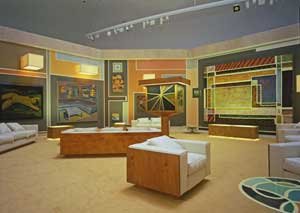Anton Henning
dal 19/1/2007 al 5/5/2007
Segnalato da
19/1/2007
Anton Henning
S.M.A.K. - Stedelijk Museum voor Actuele Kunst, Ghent
Solo show

Solo show
Anton Henning (Berlin, 1964) works in many fields. Although he is best known as a
painter, sculpture and installation art are also significant elements in his oeuvre.
By always trying to combine every art form in one all-embracing whole, his work
seems like a contemporary version of the gesamtkunstwerk, where all the various
disciplines come together and enter into dialogue with one another.
The exhibition at the S.M.A.K. is a mixture of old and new work. In addition,
Henning designed a number of pieces especially for the rooms at the S.M.A.K. The
largest piece he has ever made, Oktogon – a huge installation that merges painting,
sculpture and interior design – will also be displayed.
When creating his work, Henning always starts explicitly with painting. He plays
with all the medium’s ‘classic genres’: portrait, nude, landscape, still-life,
interiors, abstract and figurative – which he reinterprets informally and lards with
his personal and clearly recognisable visual idiom. Like a thread running through
almost all his paintings – or painting objects – Henning has a characteristic trade
mark, the ‘Hennling’, an abstract, three-lobed motif that can sometimes assume
whirling and fanning forms and sometimes appears to be the starting point for some
of his larger arabesque motifs, which can be seen in many of his abstract paintings.
Not only does Henning dabble enthusiastically in the various painting genres, but
art history (recent and otherwise) also forms an inexhaustible playground which he
refers to and pastiches to his heart’s content. So references to the great names in
painting such as Picasso and Matisse regularly crop up in his works. At the end of
the nineteenth century, when exhibitions of paintings were organised as ‘Salons’, it
was after all usual for them to be used to adorn a particular room. However, with
the rise of modernist painting the Salons, as exhibition spaces, had to make way for
the ‘white cube’, a bare white exhibition hall – comparable with the present-day
museum room – where paintings were presented completely independently and without
any direct link with the surrounding space. In fact this is still the case for a
great deal of contemporary painting.
But not in Anton Henning’s case. He sees the creation of the most suitable setting
for his work as at least as important as the paintings themselves. A perfect example
of his approach is the Oktogon, a huge octagonal installation in which he put up an
entire design interior – in a style somewhere between vintage and sixties – into
which his paintings are perfectly integrated. In this integration of works of art
and interior, Henning subtly mocks the usually holy presentation of paintings in a
clean, blinding white museum space.
But there is more than that. Henning also takes the integration of settings for his
work to the extreme so that they actually become part of the work itself, or vice
versa. In this way, many of the paintings themselves are reduced to interiors or
objects, or become the subject of all manner of sculptures and installations, which
in their turn are no longer paintings.
It is precisely this utter fusion of such traditional media as painting, sculpture
and design – and in every possible direction and combination at the same time – that
makes Henning’s work so all-embracing. Unlike the work of many other artists,
Henning’s work is never linear (in the sense of keeping to a fixed line of
development), but, conversely, functions entirely as a system in its own right, with
various ramifications that merge into one another and in their turn generate yet
more forms and images. It is a network that can go in any direction, with painting
as its starting point and Henning as its only constant.
S.M.A.K.
Citadelpark - Ghent
Open: Tuesday - Sunday, 10am - 6pm



